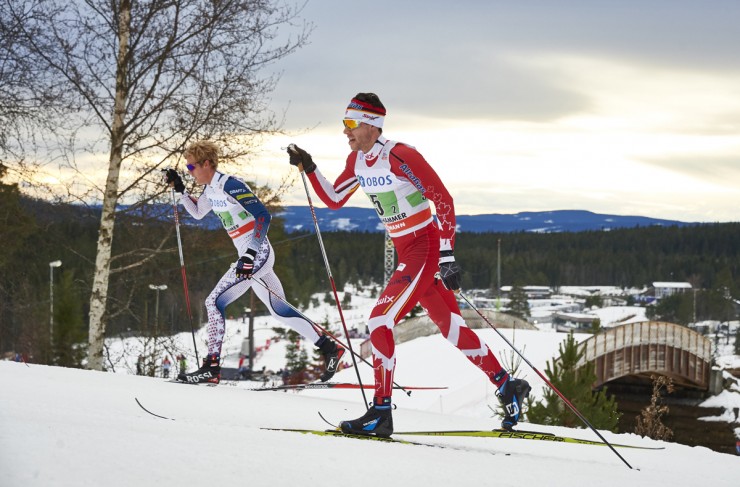
On Sunday, Erik Bjornsen of the U.S. Ski Team showed the world there’s a lot more where that came from when it comes to his classic skiing. Same goes for the U.S. men’s relay team, which flirted with fifth for at least a third of the men’s 4 x 7.5-kilometer relay at the Lillehammer World Cup in Norway. The U.S. men slipped back in the final kilometers to finish 12th, ahead of Canada in 13th.
Bjornsen, 24, clocked the fastest second-leg time of 18 teams on Sunday. He skied the second classic leg for the U.S. and completed the three-lap 7.5 k course in 19:07.9. Bjornsen was 5.7 seconds faster than Mathias Rundgreen of Norway’s third team, which ultimately placed second overall.
After receiving the tag from Andy Newell in 15th, 35.9 seconds behind the leaders (Norway’s first team: Niklas Dyrhaug, Hans Christer Holund, Martin Johnsrud Sundby, and Petter Northug Jr., which went on to win), Bjornsen lifted the U.S. to fifth, 27.4 seconds back by the race’s halfway point.
The World Cup relay returned to Lillehammer for the first time since 2013, when the U.S. women placed third to match a team best. On Sunday, the U.S. women’s team of Rosie Brennan, Sadie Bjornsen (Erik’s older sister), Liz Stephen, and Jessie Diggins repeated the feat — reaching the podium for the third time in three years in third place.
The men’s race followed on a 2.5-kilometer course. Just like in the women’s race, Norway dominated the men’s relay, entering four teams in both races for a total of 32 athletes.
Inspired by their female teammates (“That was pretty cool to see them back on the podium where they should be,” Noah Hoffman said), the U.S. men — with Newell, Bjornsen, Hoffman, and Simi Hamilton — charged hard from the start. Newell put them in third 1.2 k into the first classic leg. However, by 5 k, the Norwegians made it clear that it wasn’t a question as to whether Norway would win, but rather which Norwegian team would top the field.
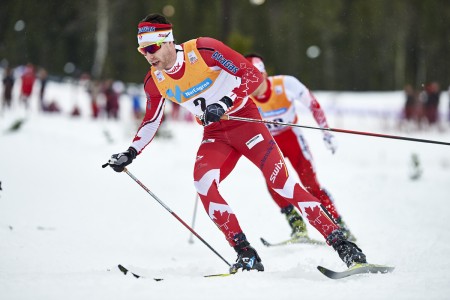
By the end of the first leg at 7.5 k, Norway’s top-three teams shared the lead. Italy’s Federico Pellegrino had snuck into third, 2.8 seconds back, while Canada’s Devon Kershaw handed off to Alex Harvey in 13th and Newell tagged Bjornsen in 15th.
“Whether you get tagged in fifth or fifteenth, it doesn’t change the way that you race,” Hoffman, the third leg, said on the phone. “You have to go out there and do the best that you can against the people that are around you and put together the best race that you can.”
This is the exact the strategy that Bjornsen applied during his relay leg. Skiing within the top 20 of the classic first half of Saturday’s skiathlon, Bjornsen explained in a phone interview on Sunday that he’s feeling good about his classic skiing.
“Once I feel the classic coming together then I know that I’m in good fitness,” he said. “The kick feels snappy so that’s helping on those hills. There’s a lot of transitioning on the Lillehammer hill and when you’re feeling good, it’s a really fun hill to ski.”
Bjornsen explained that the Lillehammer course, as tough as it is, worked in his favor..
“The hill is long and hard, but there’s a few benches that you can go from your tight stride to more stretched out, and that’s when I usually feel pretty strong,” he noted. “If I can relax in those positions, I feel like that’s one of my strengths. Whenever I was next to someone, I was pretty relaxed and confident.”
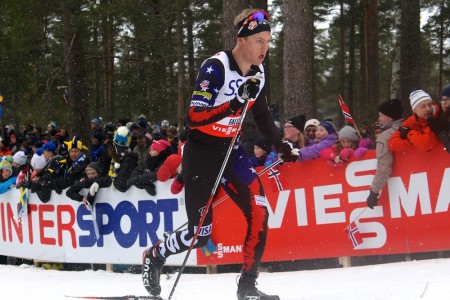
U.S Ski Team Head Coach Chris Grover reflected on the phone that “Erik in particular looked like he was having an incredible race,” he said. “He had a super-strong classic leg in the skiathlon yesterday so we knew he was in incredible shape and that classic skiing is feeling really good for him.
“We knew that he would be able to pull it together, but I don’t think that we anticipated that it would be as good as it was,” Grover added, referring to Bjornsen’s relay performance.
Bjornsen fought all the through his 7.5 k leg, and by the end of it, he had reeled his team into fifth place — 27 seconds behind Norway’s first team — with the fastest second leg. Bjornsen was pleased with his race, explaining he was “pretty surprised but happy to see that I was the fastest of that leg with some of the fastest classic skiers in the world.”
His skis helped. “We had some great performances out of all the [athletes], but really also from the service team,” Grover said. “Those guys really hit it out of the park … So it was really a big effort not only from the group of women and the guys but also from the entire staff.”
Bjornsen explained that he’s been working hard with his wax technicians to do just this, especially on days like Sunday in Lillehammer with hard, icy conditions — where choosing the right grip wax can be as challenging as keeping it on.
“Usually the women race before the men so we have limited time on the course,” Bjornsen explained. “So it’s important to come up with a strategy with your technician to make the best of your time … and try to dial in your kick and glide as best as you can. … That’s one thing that I’ve been trying to do better this year and it worked out this weekend.
“I was very happy with my classic skis both today and yesterday,” he added. “It was tricky conditions today so I went for a stronger kick, which was tricky on the corners because it was grabbing a little bit. I think that I did a good job with my wax techs dialing in the kick and foreseeing the fact that a lot of guys were going to be losing kick on some of the fast corners.”
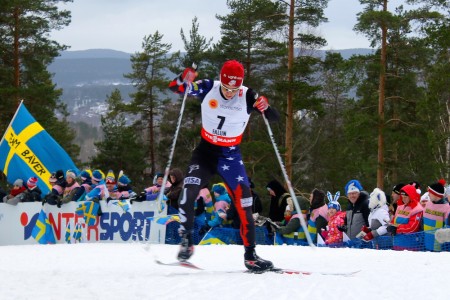
Bjornsen had a slight slipup on his second lap, falling to the ground when a Norwegian fell in front of him.
“I was in a group of five or six guys, and it was just one of those hairy corners that was icy and I was trying to get around this guy and just went down right next to him,” he explained. “Luckily I didn’t lose too much time. I got up and used my anger to go a little harder.”
Bjornsen handed off to Hoffman, and in a phone interview, Hoffman couldn’t say enough about how well Bjornsen set him up for his skate leg.
“Today all comes down to Bjornsen and how incredibly he skied, bringing us from 15th to 5th and having the best time of the day,” Hoffman said. “He set us up in a great position and I had some great drafts to ski with thanks to him. It was really impressive.”
“Today all comes down to Bjornsen and how incredibly he skied, bringing us from 15th to 5th and having the best time of the day.” — Noah Hoffman, on U.S. Ski Team teammate Erik Bjornsen
The third leg, Hoffman also skied an impressive 7.5 k, holding the USA’s position in fifth with the fifth-fastest time among his leg. Starting 13 seconds behind Norway II in fourth and three seconds ahead of Sweden in sixth, he tried not to stress about those around him.
“I was tagged less than 10 seconds ahead of [Russia I’s Alexander] Legkov and [Italy’s Roland] Clara, and those guys skied back into me very quickly,” Hoffman explained. “I didn’t go out and intend on staying ahead of them the whole time, but I knew they were going to be great rides.
“The crux of my race wasn’t in being able to hold them off in them end, and being caught by them wasn’t a big part of my race,” he added.
Legkov ended up moving into third for Russia at the final exchange, while Hoffman tagged Hamilton about 15 seconds out of fourth in fifth, 50 seconds back from the Norwegian leaders.
“I ended up skiing with [Sweden’s Martin] Johansson and Legkov,” Hoffman said. “I felt pretty relaxed skiing with them for the first couple of laps, but I couldn’t quite hang onto them on the big hill on the course.”
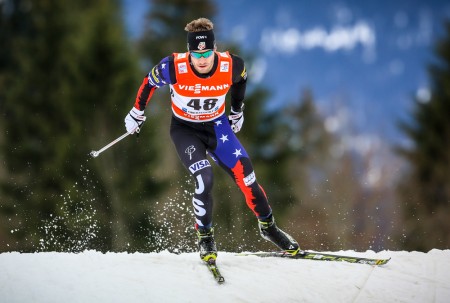
On the final leg, Hamilton slipped to 11th between 4 and 5 k. According to Grover, it was more of a positioning factor that made it difficult for him to hold onto fifth.
“It was a bit unfortunate for Simi to get tagged off in no-man’s land, and to have so many teams starting 10 seconds in front and behind him, as well as having so many great distance skaters,” Grover said, referring to Sweden, Germany, Norway IV, Italy, and Switzerland heading out 10-15 seconds after Hamilton.
“He tried to hold them off, but those guys were charging hard and they were able to work together and to draft,” Grover said. “He was kind of out there by himself so he got a bit chewed up.”
“It was a great ski by him, a great ski by Andy, and a great day of skating by Noah,” Grover summarized. “For our men to do 4 x 7.5 kilometers and to only be 1:30 back at the end is quite a performance from us.”
The Americans finished 12th overall, 1:20.6 back from Norway I as the winners.
Sundby pulled away from Norway III’s Simen Andreas Sveen in the middle of the third leg to give his team the lead. Sundby tagged Northug with a 14-second cushion to second place, and skiing uncontested throughout his 7.5 k, Northug sealed the victory in 1:13.25.7. The home nation swept podium with Norway III 2.8 seconds back in second and Norway II 14.8 seconds back from the win in third.
Finishing 20.9 seconds behind the U.S., Canada placed 13th with Kershaw, Harvey, Ivan Babikov and Graeme Killick.
“We had lots of opportunities today to move up, but we just failed to do that,” Canadian National Team Head Coach Justin Wadsworth said on the phone.
He explained that the the team struggled with their classic skis on Sunday, and also noted that for Harvey, the focus of Sunday’s race was less on results than it was for future preparations.
“With Alex, his skating has been feeling better than classic, which is why he felt like he wanted to do a classic leg today,” Wadsworth said.
Harvey skied the sixth-fastest second leg, 12.5 seconds slower than Bjornsen. After receiving the tag from Kershaw in 13th (+34.4), Harvey brought the team to 12th (+38.4). Babikov stayed in 12th (+1:16.8), and Killick closed the race out in 13th (+1:41.5) for Canada.
“Maybe it was’t the best strategic move for the relay to put [Harvey] in classic, but we’re also using these races to prepare for other races,” Wadsworth explained. “So it was an opportunity for him to get another classic effort in.
“I think we’re headed in the right direction. The results on the men’s side [Saturday] were really positive and we’re always in the hunt for a podium since we’ve started racing,” Wadsworth added.
In Saturday’s skiathlon, four Canadian men placed in the top 30.
“For Killick, it’s more top 30s and I think Devon and Ivan can also build from [the skiathlon] and look forward to the Tour de Ski,” Wadsworth said of the multi-stage series at the end of the month. “That’s really where we start to have our better results. We don’t normally ski super fast before Christmas, but Harvey’s results this year are similar to what we saw the year that Devon was second overall [in the World Cup], so we’re just trying to build. I think things overall are positive”.
Alex Kochon
Alex Kochon (alexkochon@gmail.com) is a former FasterSkier editor and roving reporter who never really lost touch with the nordic scene. A freelance writer, editor, and outdoor-loving mom of two, she lives in northeastern New York and enjoys adventuring in the Adirondacks. She shares her passion for sports and recreation as the co-founder of "Ride On! Mountain Bike Trail Guide" and a sales and content contributor at Curated.com. When she's not skiing or chasing her kids around, Alex assists authors as a production and marketing coordinator for iPub Global Connection.



